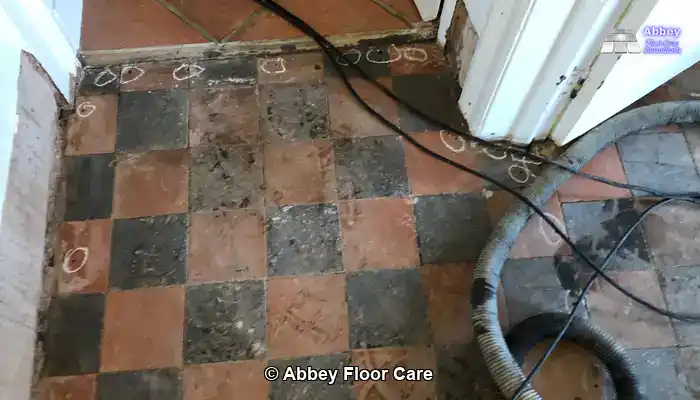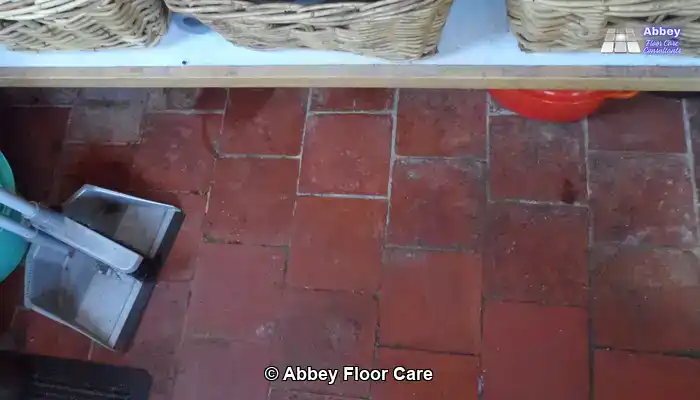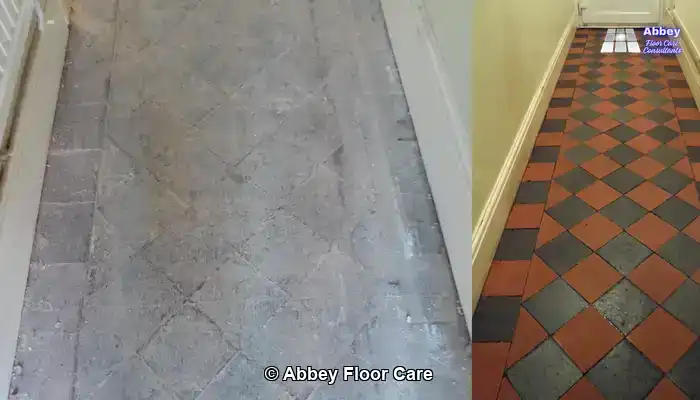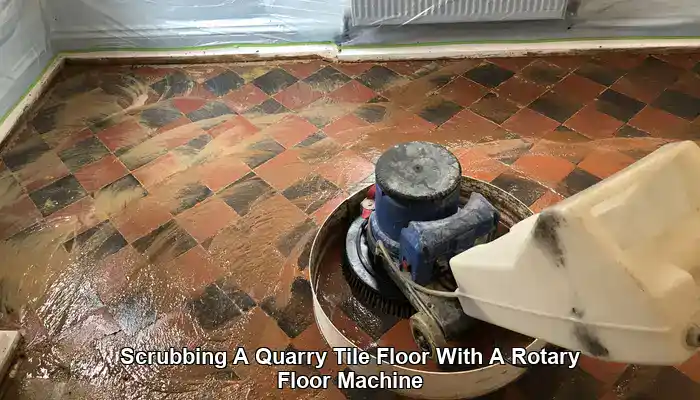Your cart is currently empty!
Deep Cleaning Quarry Tiles for a Pristine Finish


Last Updated on November 22, 2025 by David
Essential Insights for Effectively Deep Cleaning Quarry Tiles
- Older homes with quarry tiles often conceal decades of ingrained grime, especially in kitchens and utility rooms where substances like oil, wax, and dirt have deeply penetrated the porous surfaces, leading to a challenging cleaning scenario.
- Utilizing industrial cleaning techniques is essential for thorough restoration, employing rotary scrubbers, alkaline degreasers, and dwell-based strippers such as LTP Solvex to effectively dismantle stubborn layers of grime for a pristine finish.
- Sealing is a crucial step following cleaning, using breathable penetrating sealers that protect the tile without altering its appearance—or topical sealers like LTP Ironwax Satin for those desiring a sheen, provided damp conditions are not an issue.
- Post-restoration DIY maintenance is achievable, utilizing dry sweeping and pH-neutral cleaners to help maintain the finish and inhibit future grime accumulation for long-lasting cleanliness.
Why It Is Crucial for Homeowners to Deep Clean Older Quarry Tile Floors

Quarry tiles are renowned for their durability; however, in many older homes, these tiles have absorbed significant amounts of oil, wax, and dirt over the years. Particularly in kitchens and utility rooms, these tiles often remain untouched beneath appliances or worn floor coverings. Homeowners looking to rejuvenate their floors face a challenge that goes beyond simple surface cleaning. This in-depth guide explains how to tackle deeply embedded grime using industrial techniques that are both safe and effective, tailored for long-term property maintenance.
What Are the Primary Causes of Grime Accumulation on Quarry Tiles Over Time?
Identifying Factors Contributing to Grime in Kitchen and Utility Room Environments
In high-traffic areas such as kitchens and utility rooms, quarry tiles endure exposure to cooking oils, spills, and consistent foot traffic. Over time, these substances do not merely rest on the surface; they infiltrate the porous clay, creating layers that resist standard cleaning methods. When tiles remain unsealed or inadequately maintained, this absorption process accelerates, resulting in a floor that appears dull and uneven, even after regular mopping. Understanding these factors is essential for homeowners who seek to restore their tile floors effectively, ensuring they employ the right cleaning strategies.
The Impact of Oil, Wax, and Soil: Understanding the Unseen Layers Beneath the Surface
A significant number of older homes relied on wax-based polishes or oil treatments to protect quarry tiles. Although these methods provided a temporary shine, they inadvertently trapped airborne dust and cooking residues. As the layers accumulated, they formed a sticky film that clung to soil particles. This issue extends beyond mere aesthetics; it impacts traction, hygiene, and the tile’s ability to breathe. Effectively removing these layers requires more than physical effort; it necessitates a combination of chemical breakdown and mechanical agitation to achieve satisfactory results and restore the tiles to their former glory.
How to Identify When Your Quarry Tiles Need Deep Cleaning

Visual and Tactile Indicators That Reveal Embedded Dirt and Grime
It is easy to assume that a floor is clean if it appears red and uniform; however, quarry tiles often conceal grime beneath the surface. A floor that has just been mopped may still feel sticky or greasy underfoot. If you wipe a damp cloth across the tile and it appears dark or oily, this indicates the presence of embedded residues that require attention. Another telling sign is uneven sheen; areas that remain dull even after thorough scrubbing often signify wax buildup or soil trapped beneath layers of old polish. Recognizing these signs is crucial for maintaining tile cleanliness and ensuring that your flooring looks its best.
What Factors Make Homes Particularly Vulnerable to Grime Accumulation?
Many homes feature older kitchens and utility rooms that have not been modernized for years. These spaces typically contain original quarry tiles that were either never sealed or treated with outdated waxes. Over time, layers of cooking oil, detergent runoff, and tracked-in dirt accumulate. Given that these tiles are porous and unglazed, they act like sponges, especially in households with pets, children, or significant foot traffic. Even if the surfaces appear intact, the underlying grime can undermine both hygiene and visual appeal, necessitating thorough cleaning to restore the tiles to their original splendor.
Why Traditional DIY Cleaning Methods Might Not Be Enough for Heavy Buildup

What Are the Risks of Using Common Off-the-Shelf Cleaners for Quarry Tiles?
Most supermarket tile cleaners are designed to handle surface-level dirt. They frequently contain mild surfactants or acidic components that may provide a temporary shine but seldom penetrate the layers of wax, oil, and soil embedded within quarry tiles. In fact, frequent use of acidic cleaners can etch the surface, increasing porosity and susceptibility to future staining. Homeowners may discover that despite regular cleaning, their tiles remain sticky or discolored—a clear sign that deeper intervention is necessary to restore the tiles properly and effectively.
Can You Successfully Restore Quarry Tiles Without Causing Damage?
The restoration process requires breaking down decades of grime without harming the underlying clay. While quarry tiles are durable, they are also absorbent and susceptible to harsh treatments. Excessive scrubbing or the use of inappropriate chemicals can lead to uneven results or irreversible damage. Professional methods depend on controlled chemical reactions and mechanical agitation tailored to the tile’s specific condition. Achieving this balance proves challenging with DIY equipment, which often lacks the power and precision required for safe restoration that preserves the integrity of the tiles.
Exploring Effective Industrial Cleaning Techniques for Quarry Tiles
Alkaline Cleaners vs. Sealer Strippers: Essential Information for Homeowners
To effectively dismantle decades of grime, professionals employ two primary chemical methods: alkaline degreasers and sealer strippers.
- Alkaline cleaners excel at eliminating organic residues such as cooking oils, general soil, and everyday grime. They work by emulsifying grease, allowing it to be rinsed away without harming the tile.
- Solvent-based sealer removers are utilized when waxes, topical sealers, or polish layers are present. These traditional solvent-based strippers dissolve synthetic coatings quickly but can be harsh and emit strong fumes that may require additional precautions during use.
- Non-solvent sealer removers, LTP Solvex, provide a safer alternative. These non-solvent strippers penetrate the sealer and gradually soften it, similar to how paint strippers dismantle old coatings. Instead of dissolving the layer immediately, they require a dwell time of several hours or even overnight. Once softened, the residue is removed mechanically using scrubbing pads and water for a clean finish.
Selecting the appropriate product depends on your available time, your tolerance for strong odors, and the nature of the buildup you are confronting. For deep restoration—especially in situations where old sealers are present—a dwell-based stripper like LTP Solvex offers a more measured and less aggressive approach. It gradually softens the sealer, facilitating its removal with scrubbing pads and water without relying on harsh solvents or rapid chemical breakdown.
Comparing the Effectiveness of Rotary Scrubbers to Manual Brushing Techniques for Cleaning
Mechanical agitation is crucial for the restoration of quarry tiles. Rotary scrubbers utilize weighted heads and stiff brushes to drive cleaning agents deep into the surface of the tile. This technique proves significantly more effective than manual brushing, which often merely skims the surface and leaves residues behind. The combination of chemical dwell time and machine pressure ensures that embedded grime is lifted without damaging the clay. For large areas or severe buildup, rotary machines consistently deliver results that manual methods cannot replicate, making them an essential tool for thorough tile cleaning and maintenance.
How to Choose the Right Chemicals for Quarry Tile Restoration
Ensuring Safe and Effective Use of High-pH Cleaners
Alkaline cleaners with a high pH are essential for dismantling organic grime, but they must be applied cautiously. These powerful degreasers interact with oils and fats, extracting them from the tile’s surface. However, they require proper dilution and dwell time to prevent streaking or residue formation. In professional settings, technicians first test small areas and closely monitor the reaction. Homeowners attempting this without adequate training risk uneven outcomes or chemical burns to surrounding surfaces, underscoring the importance of proper application methods for achieving optimal results.
When Should You Implement Stripping Treatments for Your Tiles?
Solvent strippers are employed when wax, polish, or synthetic sealers have accumulated over time. These chemicals dissolve the coatings that trap grime beneath the surface, allowing the tile to be properly cleaned. Since solvents can release strong fumes and impact indoor air quality, they should only be used in well-ventilated areas while wearing protective gear. In older homes, chemical stripping frequently becomes the sole means to access the original tile surface, particularly in kitchens where wax-based treatments were popular in years gone by.
Understanding the Role of Mechanical Agitation in Tile Cleaning
How Rotary Machines Efficiently Remove Embedded Grime from Tiles
Rotary machines utilize weighted heads and stiff bristle pads to agitate the surface of quarry tiles effectively. This process is not simply about scrubbing harder; it involves applying consistent pressure and motion to dislodge grime from deep within the tile’s pores. The rotation of the machine aids in emulsifying dirt, allowing it to rise to the surface for safe rinsing. Without this mechanical lift, even the most potent chemicals may leave behind residues, highlighting the necessity of using appropriate equipment for effective cleaning and maintenance of the tiles.
Our company employs these machines for the majority of floor cleaning, utilizing hand pads for corners and edges that mechanical brushes and pads cannot access. This comprehensive approach ensures a thorough clean across all areas of your flooring, maximizing the impact of the cleaning process.

Understanding the Significance of Pressure and Dwell Time for Effective Cleaning
Achieving an effective clean relies on more than having the right tools at your disposal. The pressure exerted by the machine, along with the duration the chemical remains on the tile—referred to as dwell time—are both vital factors. Insufficient dwell time results in the cleaner failing to break down grime effectively, while excessive pressure risks damaging the tile’s surface. Professionals finely calibrate these variables based on the condition of the tile, ensuring a thorough clean that safeguards the floor’s integrity while delivering outstanding results that meet homeowner expectations.
Essential Post-Cleaning Procedures: Sealing and Long-Term Tile Care for Quarry Tiles
How to Determine When and What to Seal After Cleaning Your Tiles
Once quarry tiles are meticulously cleaned and thoroughly dried, sealing becomes essential to protect them from future stains and damage that can compromise their appearance. Proper sealing prevents moisture and oils from penetrating the porous surface, thereby maintaining the integrity of the tiles over time.
Choosing Between Impregnating and Penetrating Sealers for Effective Protection
A breathable, penetrating sealer is ideal for unglazed clay surfaces, especially on floors lacking a damp-proof membrane. These products penetrate the tile and create a barrier that resists oil and water without altering its natural appearance. Timing is critical—sealing too soon after cleaning risks trapping moisture, while delaying too long allows new dirt to settle. Typically, sealing should occur within 24 to 48 hours following cleaning, provided the tiles are completely dry to ensure optimal protection and longevity.
Interested in a Sheen? Consider Topical Sealers for a Glossy Finish
If you desire a satin or gloss finish, a topical sealer such as LTP Ironwax Satin serves as an excellent choice. These sealers create a surface layer on the tile, imparting a subtle sheen while helping to hide minor surface irregularities. They also facilitate easier cleaning—especially on older quarry tiles that may exhibit surface damage or crevices where dirt tends to collect. However, topical sealers are not advisable for damp-prone floors. Since they form a surface film, any moisture trapped underneath can lead to whitening, flaking, or adhesion issues. Always ensure the floor is completely dry and free from rising damp before applying a topical finish to maintain the integrity of your tile floors.
What Is the Recommended Frequency for Cleaning or Resealing Quarry Tiles?
Sealing is not a one-time solution. In high-traffic areas such as kitchens and utility rooms, the protective layer diminishes over time. Most quarry tile floors benefit from resealing every 2 to 4 years, depending on usage and cleaning routines. Regular maintenance—such as dry sweeping and the use of pH-neutral cleaners—extends the lifespan of the sealer. If tiles begin to absorb water rapidly or exhibit signs of darkening when wet, it indicates that the sealer has worn off and requires reapplication to maintain the tiles’ aesthetics and durability, ensuring they continue to look their best.
Common Questions from Homeowners About Quarry Tile Restoration
Will Deep Cleaning Change the Colour of My Tiles?
In most cases, deep cleaning restores the original color of the tiles rather than altering it. Decades of grime may darken or dull the surface, so when these layers are removed, the tile may appear brighter or more vibrant. This phenomenon does not signify a color change; rather, it represents a return to the tile’s natural state. If wax or polish has yellowed over time, stripping it away can unveil the true tone beneath, enhancing the overall appearance of your flooring and contributing to a cleaner environment.
Is the Process of Quarry Tile Restoration Messy or Disruptive?
While industrial cleaning involves machinery and chemicals, the procedure is methodical and contained. Rotary scrubbers utilize minimal water and efficiently extract waste as cleaning progresses, preventing mess and ensuring a cleaner environment. Many homeowners are pleasantly surprised by how tidy the process is, especially in comparison to DIY efforts that often leave streaks or residues behind. Adequate ventilation and preparation significantly reduce disruption, making it a manageable undertaking even in busy households, allowing you to maintain your daily routine.
Can I Successfully Maintain the Results Achieved Through Restoration?
Absolutely—once the tiles have been restored and sealed, ongoing maintenance is straightforward and achievable. Dry sweeping and occasional mopping with pH-neutral cleaners will keep the surface clean without compromising the sealer. Avoid using acidic or bleach-based products, as these can degrade the protective layer over time. With appropriate care, restored quarry tiles can remain striking and functional for many years, even in high-traffic environments, allowing homeowners to enjoy their beautiful flooring without the stress of constant upkeep.
The Article Deep Cleaning Quarry Tiles: Removing Decades of Grime first found on https://www.abbeyfloorcare.co.uk
The Article Deep Cleaning Quarry Tiles: Eradicating Years of Dirt appeared first on https://fabritec.org
The Article Deep Cleaning Quarry Tiles for a Fresh, Pristine Look Was Found On https://limitsofstrategy.com
Leave a Reply